+ データを開く
データを開く
- 基本情報
基本情報
| 登録情報 | データベース: PDB / ID: 7lbg | ||||||
|---|---|---|---|---|---|---|---|
| タイトル | CryoEM structure of the HCMV Trimer gHgLgO in complex with human Transforming growth factor beta receptor type 3 and neutralizing fabs 13H11 and MSL-109 | ||||||
 要素 要素 |
| ||||||
 キーワード キーワード | VIRAL PROTEIN/Immune System / virus / receptor / complex / neutralizing antibody / VIRAL PROTEIN / VIRAL PROTEIN-Immune System complex | ||||||
| 機能・相同性 |  機能・相同性情報 機能・相同性情報response to luteinizing hormone / transforming growth factor beta receptor complex assembly / epicardium-derived cardiac fibroblast cell development / transforming growth factor beta receptor activity, type III / inhibin-betaglycan-ActRII complex / TGFBR3 regulates activin signaling / response to follicle-stimulating hormone / muscular septum morphogenesis / definitive erythrocyte differentiation / TGFBR3 regulates FGF2 signaling ...response to luteinizing hormone / transforming growth factor beta receptor complex assembly / epicardium-derived cardiac fibroblast cell development / transforming growth factor beta receptor activity, type III / inhibin-betaglycan-ActRII complex / TGFBR3 regulates activin signaling / response to follicle-stimulating hormone / muscular septum morphogenesis / definitive erythrocyte differentiation / TGFBR3 regulates FGF2 signaling / BMP binding / vasculogenesis involved in coronary vascular morphogenesis / transforming growth factor beta receptor activity / TGFBR3 PTM regulation / regulation of transforming growth factor beta receptor signaling pathway / secondary palate development / ventricular compact myocardium morphogenesis / TGFBR3 regulates TGF-beta signaling / cardiac epithelial to mesenchymal transition / transforming growth factor beta receptor binding / type II transforming growth factor beta receptor binding / activin binding / FGFR1b ligand binding and activation / heart trabecula morphogenesis / FGFR1c ligand binding and activation / Signaling by BMP / Signaling by Activin / glycosaminoglycan binding / heart trabecula formation / definitive hemopoiesis / transforming growth factor beta binding / TGFBR3 expression / negative regulation of extracellular matrix assembly / positive regulation of cell migration involved in sprouting angiogenesis / ventricular cardiac muscle tissue morphogenesis / ventricular septum morphogenesis / negative regulation of SMAD protein signal transduction / SMAD binding / positive regulation of transforming growth factor beta receptor signaling pathway / fibroblast growth factor binding / TGF-beta receptor signaling activates SMADs / outflow tract morphogenesis / positive regulation of SMAD protein signal transduction / epithelial to mesenchymal transition / animal organ regeneration / cardiac muscle cell proliferation / BMP signaling pathway / heart morphogenesis / coreceptor activity / positive regulation of cardiac muscle cell proliferation / response to prostaglandin E / negative regulation of canonical NF-kappaB signal transduction / transforming growth factor beta receptor signaling pathway / negative regulation of cell migration / host cell endosome membrane / HCMV Late Events / PDZ domain binding / negative regulation of transforming growth factor beta receptor signaling pathway / liver development / HCMV Early Events / negative regulation of epithelial cell proliferation / transmembrane signaling receptor activity / cell migration / heparin binding / basolateral plasma membrane / host cell Golgi apparatus / entry receptor-mediated virion attachment to host cell / response to hypoxia / receptor complex / intracellular signal transduction / immune response / fusion of virus membrane with host plasma membrane / external side of plasma membrane / viral envelope / positive regulation of gene expression / symbiont entry into host cell / host cell plasma membrane / virion membrane / cell surface / extracellular space / extracellular exosome / extracellular region / plasma membrane / cytosol 類似検索 - 分子機能 | ||||||
| 生物種 |   Human cytomegalovirus (ヘルペスウイルス) Human cytomegalovirus (ヘルペスウイルス) Homo sapiens (ヒト) Homo sapiens (ヒト) | ||||||
| 手法 | 電子顕微鏡法 / 単粒子再構成法 / クライオ電子顕微鏡法 / 解像度: 2.6 Å | ||||||
 データ登録者 データ登録者 | Kschonsak, M. / Rouge, L. / Arthur, C.P. / Hoangdung, H. / Patel, N. / Kim, I. / Johnson, M. / Kraft, E. / Rohou, A.L. / Gill, A. ...Kschonsak, M. / Rouge, L. / Arthur, C.P. / Hoangdung, H. / Patel, N. / Kim, I. / Johnson, M. / Kraft, E. / Rohou, A.L. / Gill, A. / Martinez-Martin, N. / Payandeh, J. / Ciferri, C. | ||||||
 引用 引用 |  ジャーナル: Cell / 年: 2021 ジャーナル: Cell / 年: 2021タイトル: Structures of HCMV Trimer reveal the basis for receptor recognition and cell entry. 著者: Marc Kschonsak / Lionel Rougé / Christopher P Arthur / Ho Hoangdung / Nidhi Patel / Ingrid Kim / Matthew C Johnson / Edward Kraft / Alexis L Rohou / Avinash Gill / Nadia Martinez-Martin / ...著者: Marc Kschonsak / Lionel Rougé / Christopher P Arthur / Ho Hoangdung / Nidhi Patel / Ingrid Kim / Matthew C Johnson / Edward Kraft / Alexis L Rohou / Avinash Gill / Nadia Martinez-Martin / Jian Payandeh / Claudio Ciferri /  要旨: Human cytomegalovirus (HCMV) infects the majority of the human population and represents the leading viral cause of congenital birth defects. HCMV utilizes the glycoproteins gHgLgO (Trimer) to bind ...Human cytomegalovirus (HCMV) infects the majority of the human population and represents the leading viral cause of congenital birth defects. HCMV utilizes the glycoproteins gHgLgO (Trimer) to bind to platelet-derived growth factor receptor alpha (PDGFRα) and transforming growth factor beta receptor 3 (TGFβR3) to gain entry into multiple cell types. This complex is targeted by potent neutralizing antibodies and represents an important candidate for therapeutics against HCMV. Here, we determine three cryogenic electron microscopy (cryo-EM) structures of the trimer and the details of its interactions with four binding partners: the receptor proteins PDGFRα and TGFβR3 as well as two broadly neutralizing antibodies. Trimer binding to PDGFRα and TGFβR3 is mutually exclusive, suggesting that they function as independent entry receptors. In addition, Trimer-PDGFRα interaction has an inhibitory effect on PDGFRα signaling. Our results provide a framework for understanding HCMV receptor engagement, neutralization, and the development of anti-viral strategies against HCMV. | ||||||
| 履歴 |
|
- 構造の表示
構造の表示
| ムービー |
 ムービービューア ムービービューア |
|---|---|
| 構造ビューア | 分子:  Molmil Molmil Jmol/JSmol Jmol/JSmol |
- ダウンロードとリンク
ダウンロードとリンク
- ダウンロード
ダウンロード
| PDBx/mmCIF形式 |  7lbg.cif.gz 7lbg.cif.gz | 362.2 KB | 表示 |  PDBx/mmCIF形式 PDBx/mmCIF形式 |
|---|---|---|---|---|
| PDB形式 |  pdb7lbg.ent.gz pdb7lbg.ent.gz | 274.3 KB | 表示 |  PDB形式 PDB形式 |
| PDBx/mmJSON形式 |  7lbg.json.gz 7lbg.json.gz | ツリー表示 |  PDBx/mmJSON形式 PDBx/mmJSON形式 | |
| その他 |  その他のダウンロード その他のダウンロード |
-検証レポート
| 文書・要旨 |  7lbg_validation.pdf.gz 7lbg_validation.pdf.gz | 1 MB | 表示 |  wwPDB検証レポート wwPDB検証レポート |
|---|---|---|---|---|
| 文書・詳細版 |  7lbg_full_validation.pdf.gz 7lbg_full_validation.pdf.gz | 1 MB | 表示 | |
| XML形式データ |  7lbg_validation.xml.gz 7lbg_validation.xml.gz | 49.6 KB | 表示 | |
| CIF形式データ |  7lbg_validation.cif.gz 7lbg_validation.cif.gz | 75.6 KB | 表示 | |
| アーカイブディレクトリ |  https://data.pdbj.org/pub/pdb/validation_reports/lb/7lbg https://data.pdbj.org/pub/pdb/validation_reports/lb/7lbg ftp://data.pdbj.org/pub/pdb/validation_reports/lb/7lbg ftp://data.pdbj.org/pub/pdb/validation_reports/lb/7lbg | HTTPS FTP |
-関連構造データ
- リンク
リンク
- 集合体
集合体
| 登録構造単位 | 
|
|---|---|
| 1 |
|
- 要素
要素
-Envelope glycoprotein ... , 3種, 3分子 ABC
| #1: タンパク質 | 分子量: 87311.273 Da / 分子数: 1 / 由来タイプ: 組換発現 由来: (組換発現)  Human cytomegalovirus (strain Merlin) (ヘルペスウイルス) Human cytomegalovirus (strain Merlin) (ヘルペスウイルス)株: Merlin / 遺伝子: gH, UL75 / 細胞株 (発現宿主): Expi293 / 発現宿主:  Homo sapiens (ヒト) / 参照: UniProt: Q6SW67 Homo sapiens (ヒト) / 参照: UniProt: Q6SW67 |
|---|---|
| #2: タンパク質 | 分子量: 30846.492 Da / 分子数: 1 / 由来タイプ: 組換発現 由来: (組換発現)  Human cytomegalovirus (strain Merlin) (ヘルペスウイルス) Human cytomegalovirus (strain Merlin) (ヘルペスウイルス)株: Merlin / 遺伝子: gL, UL115 / 細胞株 (発現宿主): Expi293 / 発現宿主:  Homo sapiens (ヒト) / 参照: UniProt: F5HCH8 Homo sapiens (ヒト) / 参照: UniProt: F5HCH8 |
| #3: タンパク質 | 分子量: 58298.504 Da / 分子数: 1 / 由来タイプ: 組換発現 由来: (組換発現)   Human cytomegalovirus (ヘルペスウイルス) Human cytomegalovirus (ヘルペスウイルス)遺伝子: UL74 / 細胞株 (発現宿主): Expi293 / 発現宿主:  Homo sapiens (ヒト) / 参照: UniProt: Q8BCU3 Homo sapiens (ヒト) / 参照: UniProt: Q8BCU3 |
-タンパク質 , 1種, 1分子 D
| #4: タンパク質 | 分子量: 87362.203 Da / 分子数: 1 / 由来タイプ: 組換発現 / 由来: (組換発現)  Homo sapiens (ヒト) / 遺伝子: TGFBR3 Homo sapiens (ヒト) / 遺伝子: TGFBR3発現宿主:  参照: UniProt: Q03167 |
|---|
-抗体 , 4種, 4分子 EFGH
| #5: 抗体 | 分子量: 25780.020 Da / 分子数: 1 / 由来タイプ: 組換発現 / 由来: (組換発現)  Homo sapiens (ヒト) / 発現宿主: Homo sapiens (ヒト) / 発現宿主:  |
|---|---|
| #6: 抗体 | 分子量: 26600.086 Da / 分子数: 1 / 由来タイプ: 組換発現 / 由来: (組換発現)  Homo sapiens (ヒト) / 発現宿主: Homo sapiens (ヒト) / 発現宿主:  |
| #7: 抗体 | 分子量: 28355.809 Da / 分子数: 1 / 由来タイプ: 組換発現 / 由来: (組換発現)  Homo sapiens (ヒト) / 発現宿主: Homo sapiens (ヒト) / 発現宿主:  |
| #8: 抗体 | 分子量: 27547.818 Da / 分子数: 1 / 由来タイプ: 組換発現 / 由来: (組換発現)  Homo sapiens (ヒト) / 発現宿主: Homo sapiens (ヒト) / 発現宿主:  |
-糖 , 3種, 19分子 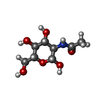
| #9: 多糖 | 2-acetamido-2-deoxy-beta-D-glucopyranose-(1-4)-2-acetamido-2-deoxy-beta-D-glucopyranose |
|---|---|
| #10: 多糖 | alpha-D-mannopyranose-(1-2)-alpha-D-mannopyranose-(1-3)-[alpha-D-mannopyranose-(1-3)-alpha-D- ...alpha-D-mannopyranose-(1-2)-alpha-D-mannopyranose-(1-3)-[alpha-D-mannopyranose-(1-3)-alpha-D-mannopyranose-(1-6)]beta-D-mannopyranose-(1-4)-2-acetamido-2-deoxy-beta-D-glucopyranose-(1-4)-2-acetamido-2-deoxy-beta-D-glucopyranose |
| #11: 糖 | ChemComp-NAG / |
-詳細
| 研究の焦点であるリガンドがあるか | N |
|---|---|
| Has protein modification | Y |
-実験情報
-実験
| 実験 | 手法: 電子顕微鏡法 |
|---|---|
| EM実験 | 試料の集合状態: 2D ARRAY / 3次元再構成法: 単粒子再構成法 |
- 試料調製
試料調製
| 構成要素 |
| ||||||||||||||||||||||||
|---|---|---|---|---|---|---|---|---|---|---|---|---|---|---|---|---|---|---|---|---|---|---|---|---|---|
| 分子量 | 値: 0.36 MDa / 実験値: NO | ||||||||||||||||||||||||
| 由来(天然) |
| ||||||||||||||||||||||||
| 由来(組換発現) |
| ||||||||||||||||||||||||
| 緩衝液 | pH: 7.5 | ||||||||||||||||||||||||
| 緩衝液成分 |
| ||||||||||||||||||||||||
| 試料 | 濃度: 0.5 mg/ml / 包埋: NO / シャドウイング: NO / 染色: NO / 凍結: YES / 詳細: This sample was monodisperse | ||||||||||||||||||||||||
| 試料支持 | グリッドの材料: GOLD / グリッドのサイズ: 300 divisions/in. / グリッドのタイプ: Quantifoil R1.2/1.3 | ||||||||||||||||||||||||
| 急速凍結 | 装置: LEICA EM GP / 凍結剤: ETHANE / 湿度: 100 % / 凍結前の試料温度: 277 K / 詳細: blot for 3.5 seconds before plunging |
- 電子顕微鏡撮影
電子顕微鏡撮影
| 実験機器 |  モデル: Titan Krios / 画像提供: FEI Company |
|---|---|
| 顕微鏡 | モデル: FEI TITAN KRIOS |
| 電子銃 | 電子線源:  FIELD EMISSION GUN / 加速電圧: 300 kV / 照射モード: FLOOD BEAM FIELD EMISSION GUN / 加速電圧: 300 kV / 照射モード: FLOOD BEAM |
| 電子レンズ | モード: BRIGHT FIELD / 倍率(公称値): 165000 X |
| 試料ホルダ | 凍結剤: NITROGEN 試料ホルダーモデル: FEI TITAN KRIOS AUTOGRID HOLDER |
| 撮影 | 平均露光時間: 10 sec. / 電子線照射量: 50 e/Å2 フィルム・検出器のモデル: GATAN K2 SUMMIT (4k x 4k) 撮影したグリッド数: 1 / 実像数: 19993 / 詳細: Images were collected in 50 frames every 0.2 s |
| 画像スキャン | 動画フレーム数/画像: 50 |
- 解析
解析
| EMソフトウェア |
| ||||||||||||||||||||||||||||||||||||||||||||||||||||||||||||
|---|---|---|---|---|---|---|---|---|---|---|---|---|---|---|---|---|---|---|---|---|---|---|---|---|---|---|---|---|---|---|---|---|---|---|---|---|---|---|---|---|---|---|---|---|---|---|---|---|---|---|---|---|---|---|---|---|---|---|---|---|---|
| CTF補正 | タイプ: PHASE FLIPPING AND AMPLITUDE CORRECTION | ||||||||||||||||||||||||||||||||||||||||||||||||||||||||||||
| 粒子像の選択 | 選択した粒子像数: 2780519 | ||||||||||||||||||||||||||||||||||||||||||||||||||||||||||||
| 対称性 | 点対称性: C1 (非対称) | ||||||||||||||||||||||||||||||||||||||||||||||||||||||||||||
| 3次元再構成 | 解像度: 2.6 Å / 解像度の算出法: FSC 0.143 CUT-OFF / 粒子像の数: 2737199 詳細: Used a score threshold of 0.25 for final 3D reconstruction. Map used for model refinements is a composite map after combining 2 focussed maps with PHENIX 対称性のタイプ: POINT | ||||||||||||||||||||||||||||||||||||||||||||||||||||||||||||
| 原子モデル構築 | プロトコル: AB INITIO MODEL / 空間: REAL |
 ムービー
ムービー コントローラー
コントローラー










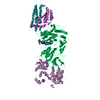
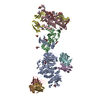

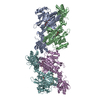

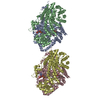
 PDBj
PDBj







